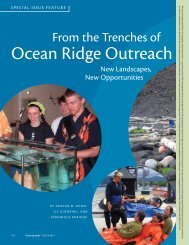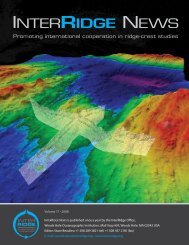Full version, low resolution, 7.5MB - InterRidge
Full version, low resolution, 7.5MB - InterRidge
Full version, low resolution, 7.5MB - InterRidge
You also want an ePaper? Increase the reach of your titles
YUMPU automatically turns print PDFs into web optimized ePapers that Google loves.
National News<br />
National News<br />
Australia<br />
Jo Whittaker<br />
Australia has one of the world’s largest marine territories, much of<br />
which remains unexplored, with only one blue-water research vessel<br />
available to our marine research community. In an exciting<br />
development, Australia has commissioned a new research vessel, the<br />
RV Investigator. The Marine National Facility’s new state-of-the-art<br />
research facility is currently under construction. Fol<strong>low</strong>ing a<br />
commissioning year in 2013-2014, RV Investigator will be available<br />
for research in 2014-2015. The new vessel will be capable of<br />
operating continuously for 60 days at sea, cruising at 12 knots over<br />
a range of 10,000 nautical miles.<br />
RV Investigator will be a highly advanced research vessel with a broad<br />
range of scientific equipment to support marine scientists, including<br />
a wide range of marine geosciences, oceanography and climatology,<br />
and fisheries, marine ecosystem and marine environmental research.<br />
Additionally, through the AuScope’s Australian Geophysical<br />
Observing System (AGOS), Australia has committed to acquiring<br />
20 Ocean Bottom Seismometers by 2014, an addition that will be<br />
invaluable to geophysical exploration of the ocean basins<br />
surrounding Australia.<br />
In November 2011, Dr Simon Williams from the University of<br />
Sydney led a successful international team on a scientific voyage to<br />
the Perth Abyssal Plain. The Perth Abyssal Plain is one of the more<br />
poorly understood ocean basins surrounding Australia. The cruise<br />
collected magnetic, bathymetric and dredge data to address<br />
knowledge gaps regarding the nature and evolution of the basin.<br />
The voyage achieved its scientific aims including the collection of six<br />
magnetic anomaly profiles across the Perth Abyssal Plain, and the<br />
collection of swath and dredge data from seven sites on the Batavia<br />
Knoll, Gulden Draak Ridge and Dirck Hartog Ridge. Continental<br />
material was recovered from the Batavia Knoll and Gulden Draak<br />
Ridge indicating that these features are micro-continents rifted from<br />
India during the breakup between Australia and India.<br />
In May-June 2012 Dr Richard Arculus from the Australian National<br />
University led a scientific voyage to the northern Lau Backarc Basin<br />
to investigate magmatism, tectonics and hydrothermal activity. The<br />
northern Lau Basin is a region of rapidly extending and newlyforming<br />
crust, seamed by multiple zones of sea-floor spreading,<br />
rifting and faulting consequent to the clockwise rotation of the<br />
Tonga Arc away from the Fiji-Lau Ridge. The demise of the former<br />
Vitiaz Arc has led to the establishment of a new Australian-Pacific<br />
plate boundary that wraps around the north end of Fiji, and<br />
R/V Investigator in progress<br />
(Acknowl. www.csiro.au)<br />
connects with the Tonga Trench via a set of ridges (e.g. Futuna<br />
Spreading Centre, Northwest Lau Spreading Centre), rifts (e.g.<br />
Rochambeau Rifts), transform faults and extension zones. The<br />
voyage explored these tectonic elements and the accompanying<br />
magmatism and hydrothermal activity.<br />
In Oct-Nov 2012, Dr Maria Seton of the University of Sydney will<br />
lead a voyage to the eastern Coral Sea. The main objectives of this<br />
voyage are to investigate (i) the nature of the crust<br />
(continental/volcanic/oceanic) underlying Rennell Island, East<br />
Rennell Island Ridge, South Rennell Fracture Zone and<br />
d’Entrecasteaux Zone, and (ii) the age and structure of the Santa<br />
Cruz/Torres and d’Entrecasteaux Basins. We will also explore<br />
whether the basins formed in a back-arc setting related to<br />
Cretaceous or Eocene subduction or whether they preserve a piece<br />
of oceanic crust from the Panthalassa Ocean, and (iii) the extension<br />
of the Lord Howe hotspot trail into the eastern Coral Sea, north of<br />
the Bellona Plateau.<br />
Dr Maria Seton from the University of Sydney is the Chair of the<br />
new Back and Island Arc (BI-ARC) Working Group. The working<br />
group hopes to foster a holistic approach to address fundamental<br />
questions about intra-oceanic arc and backarc basin processes by<br />
examining the long-term and short-term evolutionary cycles using<br />
geochemical, hydrothermal, biological, tectonic and subduction<br />
dynamics approaches. In addition, we aim to bridge the gap between<br />
geologists who study onshore, accreted island-arc and back-arc<br />
systems and marine geoscientists who study in-situ backarc systems.<br />
The working group seeks to bring together experts from both the<br />
observational and modeling communities to facilitate the linkage<br />
between surface processes and the deep earth.<br />
INTERRIDGE NEWS 35 VOL.21, 2012
















